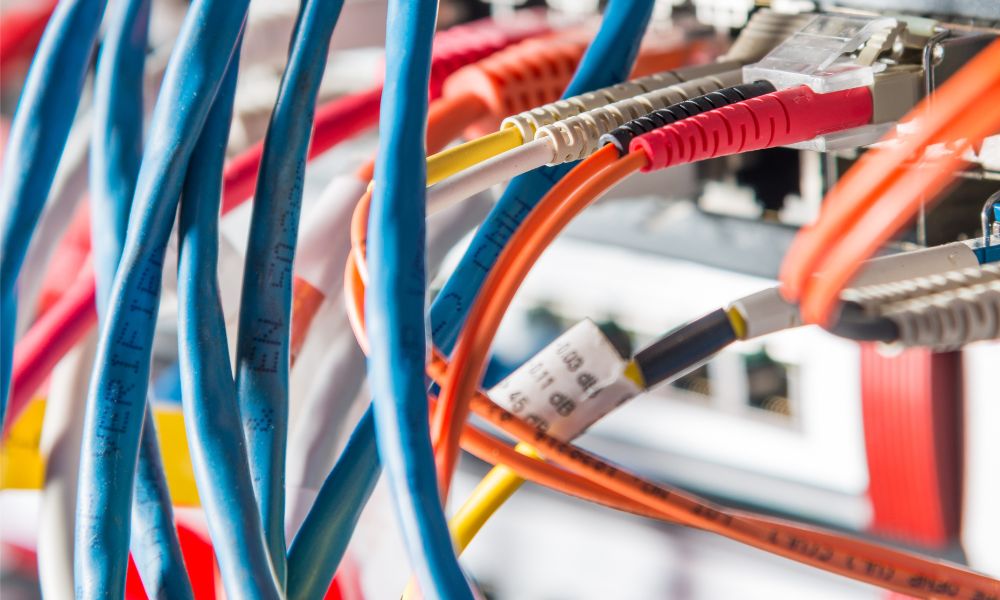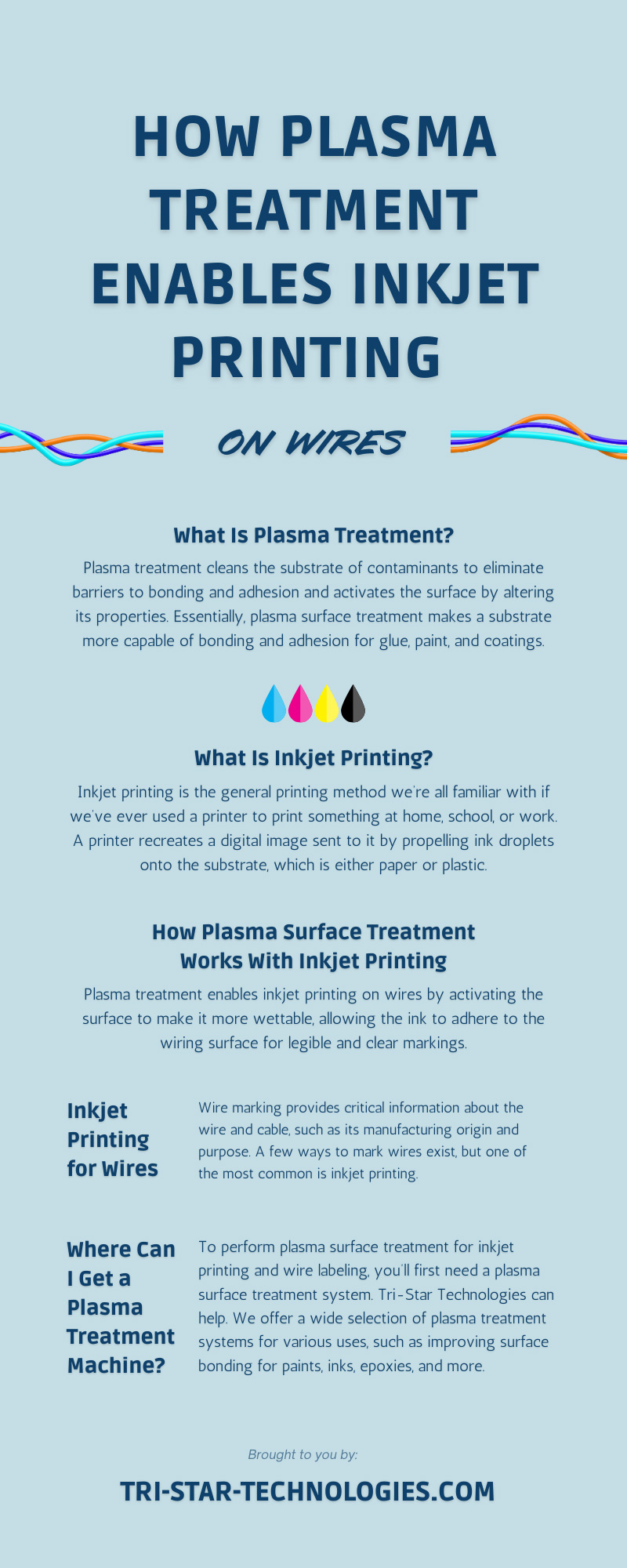How Plasma Treatment Enables Inkjet Printing on Wires

Have you ever wondered how electrical wires and cables have such fine markings and labels? Wire marking is critical to electrical safety and organization, and in many cases, inkjet printing on wires would not be possible with plasma treatment. Below, we explain how industrial processes like plasma treatment enable inkjet printing on wires through surface activation.
What Is Plasma Treatment?
Before we get into the intersection of plasma treatment, inkjet printing, and wire marking, we have to understand what it means to treat something with plasma. Basically, plasma treatment is for altering the surface properties of a substrate on a molecular level.
Plasma treatment cleans the substrate of contaminants to eliminate barriers to bonding and adhesion and activates the surface by altering its properties. Essentially, plasma surface treatment makes a substrate more capable of bonding and adhesion for glue, paint, and coatings.
How Does Plasma Surface Treatment Work?
To understand how plasma surface treatment works, you must first understand what plasma is. While you’ve heard of plasma before, you might be unable to define it. Basically, plasma is considered the fourth state of matter alongside solid, liquid, and gas.
Plasma is created by adding energy to gas molecules until they’re ionized and carry a net positive charge that affects the overall electrical characteristics of the gas. This gas soup of energetic, reactive species in plasma includes positive ions, electrons, neutral gas atoms, and more, and it interacts with a surface during plasma treatment. The reactive species alter the substrate to enhance its wettability, and the varying makeup of the plasma mixture and pressure during treatment can tune the treatment’s effects to the user’s desires.
The Benefits of Plasma Surface Treatment
Now you know what plasma surface treatment is and how it works, but what are its benefits? A few of the most notable advantages to plasma treating a substrate include increased adhesion, versatile applications, and eco-friendliness.
Improved Adhesion
The primary reason industrial businesses use plasma surface treatment is that it instantly improves the adhesion or wettability of the surface substrate. The surface activation from the treatment makes the material more pliable for bonding, painting, or whatever else is necessary. This surface activation is key for materials with low surface energy, such as plastics or polymers like silicone.
Everyone who has tried to glue two plastics together or paint a plastic surface understands that the material is not naturally conducive to bonding with an external material. As wires and cables are often coated with insulation and plastic materials, plasma surface treatment makes inkjet printing on the surfaces possible.
Versatile Applications
Another significant benefit of plasma surface treatment is that it applies to various materials and surfaces. Plasma surface treatment is common on plastic surfaces—such as PEEK, PTFE, or PP—but not restricted to such materials. Other materials that can undergo plasma surface activation include the following:
- Glass
- Ceramics
- Metals
- Alloys
Plastic is common because plastic, polymers, rubbers, and other materials are becoming more common in industrial manufacturing. Plasma surface treatment makes these materials better for adhesion bonding and painting, allowing manufacturers to continue using plastic materials to keep products lightweight and structurally sound.
Eco-Friendliness
Industrial manufacturers also appreciate plasma surface activation because it’s environmentally friendly. Many manufacturing practices, especially those relating to adhesive bonding or painting, require harmful chemicals or elevated carbon emissions to work, making it a sacrifice between practicality and eco-consciousness.
Plasma surface treatment, however, works in an evacuated enclosure like a vacuum chamber and doesn’t produce any harmful emissions or waste. Therefore, there’s no negative effect on the outside environment. Plasma surface treatment is a green and clean process for industrial manufacturers!
What Is Inkjet Printing?
We’ve discussed the plasma surface treatment aspect of the process, but what about inkjet printing? Inkjet printing is the general printing method we’re all familiar with if we’ve ever used a printer to print something at home, school, or work. A printer recreates a digital image sent to it by propelling ink droplets onto the substrate, which is either paper or plastic. Industrial settings use inkjet printing for many applications, including industrial wire marking.
Inkjet Printing for Wires
Industrial wire marking is a crucial aspect of electrical safety and organization. Anyone in an office or industrial workplace knows how many wires must crisscross back and forth through the building to provide electrical power. With hundreds and thousands of wires to keep track of, we need many ways to mark and label them. These methods include color coding, using flag labels, and most importantly, wire marking.
Wire marking provides critical information about the wire and cable, such as its manufacturing origin and purpose. A few ways to mark wires exist, but one of the most common is inkjet printing.
How Plasma Surface Treatment Works With Inkjet Printing
While inkjet printing is common for wire marking, many variables can cause problems, like the wire insulation material or cable coating. This is because wire insulation must be durable and have certain properties that make printing difficult, like being moisture proof and heat resistant. Applying wet ink to a waterproof material can be impossible, so this is where plasma treatment comes in.
Plasma treatment enables inkjet printing on wires by activating the surface to make it more wettable, allowing the ink to adhere to the wiring surface for legible and clear markings.
Where Can I Get a Plasma Treatment Machine?
To perform plasma surface treatment for inkjet printing and wire labeling, you’ll first need a plasma surface treatment system. Tri-Star Technologies can help. We offer a wide selection of plasma treatment systems for various uses, such as improving surface bonding for paints, inks, epoxies, and more.
You’ll find a quality plasma surface system at Tri-Star Technologies, no matter the type of plastic or other material you need to adjust for quality inkjet marking.
Conclusion
We hope our guide has helped explain the basics of plasma surface treatment, inkjet printing, and their intersections. If you have additional questions about plasma treatment machines or are interested in purchasing one for your industrial process, contact our helpful staff. We can help you find the ideal system for your application today!



